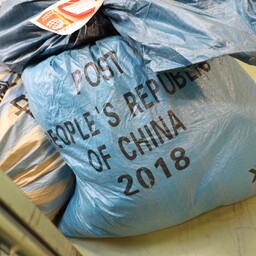Hiina veebipoodidest Eestisse tuleva kauba maht on viimastel aastatel
kümnekordistunud
. See suur kasv on muutunud suureks probleemiks tolliteenistusele. Eelmisel aastal saabus Euroopasse 4,6 miljardit saadetist, millest 98% pärines Hiinast.
kümnekordistunud
Tõlge fraasile: kümnekordistunud
EN
increased tenfold
Maksu- ja tolliameti (MTA) esindaja Ursula Riimaa ütleb, et alates 2021. aastast on
e-kaubanduse kasv
olnud
plahvatuslik
. Näiteks ühe lennuga Eestisse jõudv kauba maht on võrdne varasema ühe kuu mahuga. See suur kasv tõstab oluliselt
tolli töökoormus
t.
e-kaubanduse kasv
Tõlge fraasile: e-kaubanduse kasv
EN
growth of e-commerce
plahvatuslik
Tõlge fraasile: plahvatuslik
EN
explosive
tolli töökoormus
Tõlge fraasile: tolli töökoormus
EN
customs workload
Kõik saadetised läbivad
esmase riskianalüüsi
ja neid kontrollitakse juhuslikult. Riimaa lisab, et iga saadetist ei jõua kontrollida, kuid tolliteenistus teeb kõik, et Eestisse ei jõuaks ohtlikud ega keelatud kaubad.
esmase riskianalüüsi
Tõlge fraasile: esmase riskianalüüsi
EN
primary risk analysis
Pakke tellitakse järjest rohkem Hiinast ja sellel on mitu põhjust. Üheks põhjuseks on USA tollieeskirjad, aga ka inimeste
tarbimisharjumuste muutumine
. Samuti on leitud
mugavad logistilised koridorid
ja liikmesriikide tollide lihtsamad teenused.
tarbimisharjumuste muutumine
Tõlge fraasile: tarbimisharjumuste muutumine
EN
change in consumption habits
mugavad logistilised koridorid
Tõlge fraasile: mugavad logistilised koridorid
EN
convenient logistics corridors
Riimaa räägib ka maksude tasumisest. Paljud kaubad ei ole
deklareeritud korrektselt
ja väärtusi näidatakse valesti. See võib põhjustada segadust ostjatel, kes arvavad, et hind veebipoes oli teine kui maksude tasumise ajal.
deklareeritud korrektselt
Tõlge fraasile: deklareeritud korrektselt
EN
declared correctly
Euroopa Liit on alustanud uute meetmetega, et aidata selle probleemiga. 2021. aastal kehtestati
käibemaksu erikord
, mis on juba näinud oma positiivseid tulemusi. Siiski on e-kaubanduse mahtudega raske toime tulla.
käibemaksu erikord
Tõlge fraasile: käibemaksu erikord
EN
special VAT regulation
MTA esindaja lisab, et tollil on ka teisi ülesandeid, nagu
sanktsioonikontrollid
. Eelmisel aastal tehti üle 500 000 sellist kontrolli. Väljakutseid on palju, kuid tolliteenistus püüab nendega
hakkama saada
.
sanktsioonikontrollid
Tõlge fraasile: sanktsioonikontrollid
EN
sanction controls
hakkama saada
Tõlge fraasile: hakkama saada
EN
cope
The volume of goods arriving in Estonia from Chinese online stores has increased tenfold in recent years. This significant growth has become a major problem for the customs service. Last year, 4.6 billion shipments arrived in Europe, 98% of which came from China.
Ursula Riimaa, a representative of the Tax and Customs Board (MTA), says that since 2021, the growth of e-commerce has been explosive. For example, the volume of goods arriving in Estonia on one flight is equivalent to the volume of one month in the past. This significant growth increases the workload of customs substantially.
All shipments undergo initial risk analysis and are randomly inspected. Riimaa adds that not every shipment can be checked, but the customs service does everything to ensure that dangerous or prohibited goods do not enter Estonia.
Packages are increasingly ordered from China, and there are several reasons for this. One reason is US customs regulations, as well as changes in people's consumption habits. Convenient logistics corridors and simplified customs services in member states have also been established.
Riimaa also talks about paying taxes. Many goods are not declared correctly, and values are indicated incorrectly. This may cause confusion among buyers who think the price in the online store was different from that at the time of paying taxes.
The European Union has started implementing new measures to help with this problem. In 2021, a VAT exemption was introduced, which has already shown positive results. However, it is difficult to cope with the volumes of e-commerce.
The MTA representative adds that customs also has other tasks, such as sanctions controls. Last year, over 500,000 such checks were carried out. There are many challenges, but the customs service is trying to cope with them.

